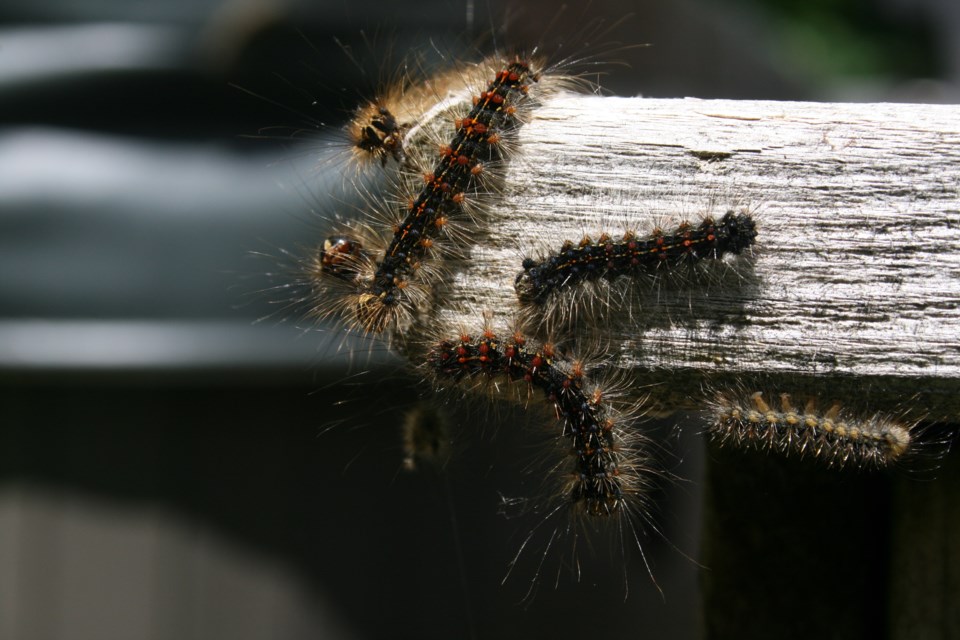If the topic of invasive LDD moths last year was a viral conversation across Ontario, then every concerned resident would do themselves a favour to rewatch this meeting.
As part of a request by Tiny council, three groups of experts provided base level information on the LDD (Lymantria dispar dispar), formerly called ‘gypsy moths,' for insight into how the township should approach municipal spraying entering 2022.
“Recently, the name change has been confirmed to become ‘spongy moths,'” clarified the first speaker, Dan Rowlinson of Provincial Forest Health Monitoring, for the Ministry of Northern Development, Mines, Natural Resources and Forestry (NDMNRF).
Rowlinson explained that although trees affected by LDD infestations “look really bad," the invasive species is a defoliator and not a primary tree-killer.
“Coniferous trees (have) a little bit different level of tolerance than deciduous trees which are typically targeted,” noted forester Graeme Davis of Simcoe County.
Spruce and white pine conifers which become defoliated, or stripped, don’t have the opportunity to do a re-flush of foliage throughout the year unlike deciduous trees such as oak and white ash; the inability to store root starch for the upcoming year is a factor in tree mortality.
Throughout the meeting, Rowlinson continually referred to the invasive species as “the beast."
Egg masses found on foliage and the ground floor of forests were surveyed by the county as well as through the Severn Sound Environmental Association (SSEA), and along with aerial surveys by the province, a forecast of LDD population decline was anticipated for 2022.
“There’s a number of factors that result in the collapse of an LDD outbreak,” noted Davis, “but that NPV (nuclear polyhedrosis virus) is a key indicator.” Surveyed plots by the county indicated NPV in all instances.
According to invasive species program coordinator Tamara Brincat, and wetland and habitat biologist Michelle Hudolin of SSEA, plots in Dubeau Forest of Tiny were found to have NPV, parasites, and the fungus E. maimaga which resulted in a nil to moderate defoliation forecast for 2022.
Rowlinson remarked, “It’s encouraging to see the results that Graeme and Tamara have presented mesh with my messaging that we’re starting to see this across the province; that’s an indication that the entire outbreak is starting to show signs of decline.”
Questions from council revolved around the need for aerial spray as a municipal expense, the cost, and the health issues associated with BTK pesticide usage on the larval caterpillars.
“If you’ve eaten lettuce from the grocery store, you’ve ingested BTK,” stated Rowlinson on the non-toxic impact of the pesticide on humans. “Birds and mammals have acidic digestive systems,” he noted in clarifying that BTK droplets of 30 to 40 microns in size crystallize in the alkaline components of moths and butterflies.
Additionally, butterflies have different timing for their life cycle than LDD, which is the reason why early spring is the required time for maximum impact to aerial spray foliage with BTK, which only has a shelf life of 48 hours.
A report from council looking at the costs of possible municipal spray for Tiny in 2022 revealed that it was cost-prohibitive to tackle the issue at large. Public works director Tim Leitch explained the chart attached to the report.
“If we sprayed 10 per cent of the 67,000 acres based on the egg mass mapping of Option 1,” said Leitch, “if we spread it out over every single property we have which is 12,593 – whether they’re inhabited or vacant – it would be $168 per property owner. And that would be a flat rate for every property owner within the township whether they’re affected or not.”
Option 2 for only affected properties averaged roughly $300 per acre or a flat rate of just over $1,600 per property along with the cost of dedicated township staff for sprayed properties. The cost for the municipality to spray the 10 per cent of properties was calculated at $2.1 million.
Coun. Gibb Wishart rationalized the costs “in a nutshell,” stating that to spray 100 acres of his own property would cost between $20,000 to $30,000, which Leitch confirmed.
Citing the cost-prohibitive nature of the spray program along with the forecasted decline of LDD in 2022, council voted for Option 3: that Tiny does not engage in the municipally-run spray program, and that individual property owners could opt in or out of the program to be funded by those that register with a spray provider.
The agenda and information provided to the special meeting of council for the LDD moth infestation is located on the Tiny Township website.
Further information on LDD can be found on the environmental services page of the Tiny Township website.
Archives of council meetings are available to view on Tiny Township’s YouTube channel.



